The Saddest Affair: A Geologic Perspective on the Battle of the Crater, U.S. Civil War
One hundred and fifty years ago this week a terrible and pernicious battle was fought at Petersburg, Virginia during the American Civil War. In the summer of 1864 the Confederate and Union armies were at a stalemate; dug in and facing each other across a long front. Lt. Colonel Henry Pleasants, a mining engineer from northeastern Pennsylvania, proposed digging a tunnel (in essence a mine shaft) beneath the Confederate lines and then setting off explosives to pierce the Southern defenses. The Union troops would then storm the breach with the prospect of a significant breakthrough on the Petersburg front.
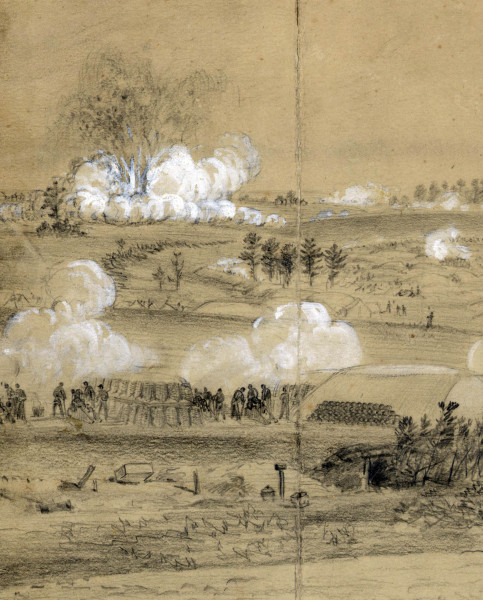
Explosion that created the Crater. From a contemporary sketch by Alfred Waud entitled “Before Petersburg at sunrise, July 30th 1864”. (http://www.loc.gov/pictures/item/2004660459/)
Union general George Meade originally thought the proposition little more than a curious endeavor to occupy bored troops. Between June 25th and July 17th, Pleasants’ men excavated a 500-foot (~150 m) tunnel from just behind the Federal lines to a location immediately beneath the Confederate position. Eventually the plan was embraced by the Union high command and just before dawn on July 30th, 1864 ~8,000 lbs. (~3,600 kg) of gunpowder was detonated in subsurface galleries. In an instant the explosion violently displaced ~400,000 cubic feet of earth (~11,000 m3, that’s equivalent to about 50 modern railroad boxcars) and in the process killed more than 250 Confederate soldiers. A massive crater with a ragged maw and steep walls, upwards of 25’ high (9 m), was created. In the aftermath a cloying dust cloud settled back to the surface coating both Confederate and Union troops.
Rather than immediately storm through the breach, Union troops reacted with confused caution. Ladders and footbridges weren’t available to facilitate Union troop movement out of their own trenches. After traversing the no-man’s land between the lines many Union troops went into the Crater as opposed to going around it, as called for in the original battle plan. Eventually the Confederates regrouped and mounted a counterattack on the Union forces, now mostly stuck in the Crater. Rather than cutting the ever-growing Union losses, General Ambrose Burnside sent a division of the Unites States Colored Troops into the Crater. What ensued was effectively a race riot and many black soldiers were massacred after they’d surrendered. By midday the Confederates had regained the lost ground and the Union was routed. Between 5,000 and 6,000 men were killed, wounded, or captured during the battle of the Crater (the vast majority of casualties were from the Union army). General Ulysses Grant lamented, “it was the saddest affair I’ve witnessed in this war.”
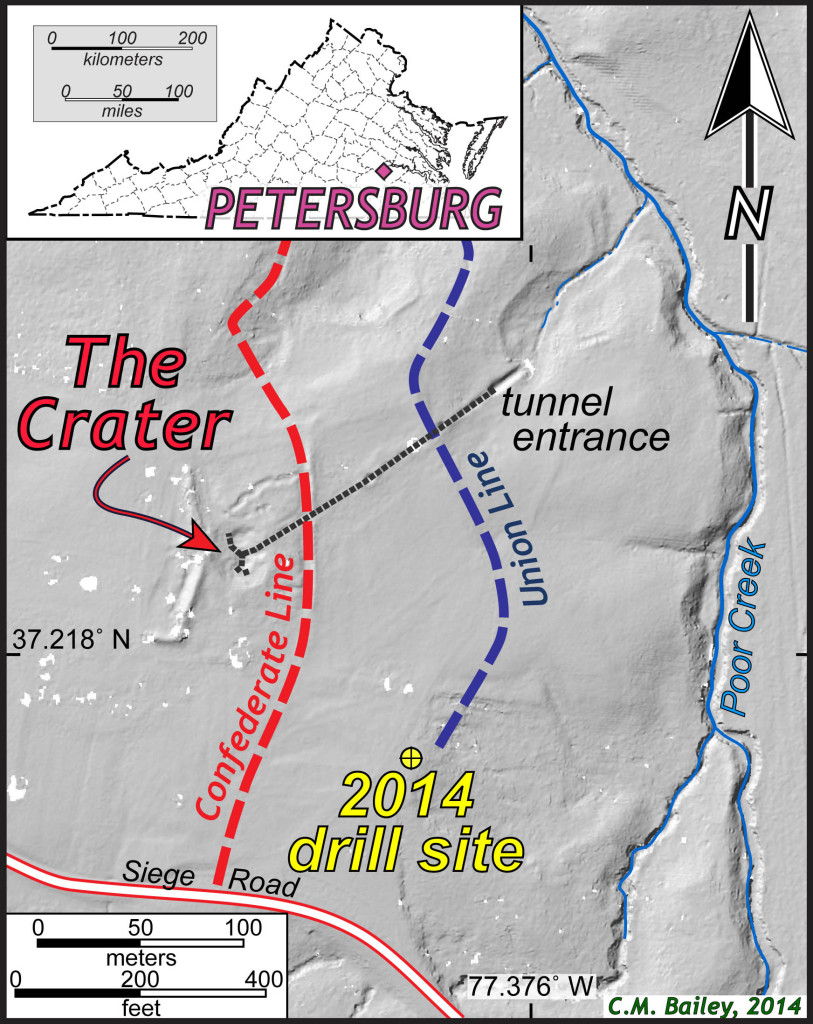
Map of the Crater at Petersburg National Battlefield, Virginia. Thick gray dashed line is the approximate location of the Union tunnel. The base map is a grayscale shaded relief map from LIDAR data courtesy of the National Park Service.
My purpose is not to fully review the martial events of that awful morning, many books and scholarly articles dissect that topic, but rather to focus on the underlying geology and its bearing on both the preparations for and the battle itself.
Earlier this summer my research students and I joined with Rick Berquist from the Virginia Division of Geology and Mineral Resources and his trunk-mounted auger drill rig to investigate the subsurface geology at the Crater site. Our drill site was located ~400’ (~120 m) southeast of the Crater and supplements core data that Rick obtained 15 years ago.
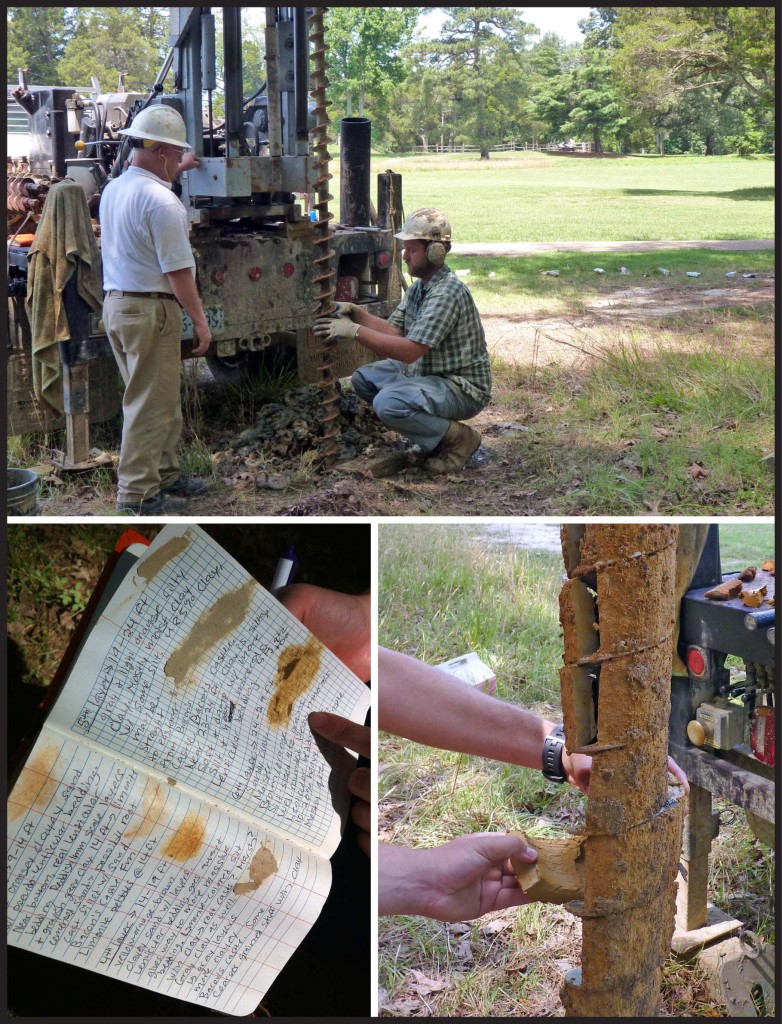
Photos from the drill site at the Crater, Petersburg National Battlefield. Upper: Rick Berquist (left) and Lee Bristow (right) operating the drill, the Crater is in the background ~400’ (120 m) to the north of the drill site. Lower Left: Field notes from the drilling operation, sediment dabs in the field book make for an excellent and colorful record that supplements later analysis. Lower Right: Geologist’s greedy hands pry sediment off the drill stem, note the cohesive nature of the sediment on the auger.
To set the geologic scene, the Petersburg battlefield is located at the western edge of the Atlantic Coastal Plain, a region underlain by sediments and sedimentary rocks deposited in and along the margin of the Atlantic Ocean during the Cenozoic (the last 65 million years). Throughout Earth history, as climate has changed, as ocean basins grew or shrunk, and as tectonic activity has rippled the continents oceans have risen and fallen. During intervals of high sea level the Atlantic shoreline stood near or just west of modern day Washington D.C., Fredericksburg, Richmond, and Petersburg. Over time sediment was deposited on the sea floor, many of these layers contain fossils such as scallops and shark teeth that provide evidence of the organisms that inhabited those shallow seas. During intervals in which sea level was low, the landscape was exposed, weathered and eroded. As the Atlantic’s water rose, transgressing once more over the Coastal Plain, the next layer of marine sediment accumulated with unconformity on the strata below.
At many battle sites in the Civil War’s Eastern Theater, however a tunneling operation would never have been possible. Along Petersburg front the underlying Coastal Plain materials are primary unconsolidated sediment rather than properly lithified sedimentary rocks. Thus Lt. Colonel Pleasants regiment was able to use hand tools for digging into the underlying sand, silt, and muddy layers. Had the subsurface contained solid rock, such as sandstone or granite, then blasting would have been required and there’d likely have been no Battle of the Crater. Although the tactical situations were far different at Manassas, Antietam, and Gettysburg the underlying geology at those battle sites would have made tunneling difficult or impossible.
Petersburg is located at the Fall Zone, along the Coastal Plain’s western edge, and at the battlefield there is modest topographic relief (~60’ or ~20’) between the low hillcrests and the stream bottoms which provided: 1) cover for the Union mine such that it was below and out-of-sight of the Confederate lines, and 2) for adequate drainage in the subsurface. This tunneling operation would have been nearly impossible along the low and saturated ground near the James, Chickahominy, or Appomattox rivers.
In spite of doubts from the Union engineers, the 48th Pennsylvania Infantry regiment adroitly excavated their tunnel and devised an ingenious system for venting the mine by replacing stagnant air with fresh via a forced air circulation system.
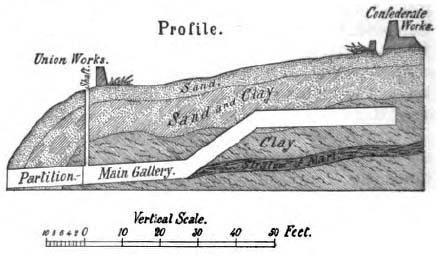
Cross section of the Union tunnel by Lt. Colonel Henry Pleasants with description of the subsurface materials. Note the sketch is vertically exaggerated. From Battles and Leaders of the Civil War, v. 4, pg. 548.
However, as Lt. Colonel Pleasants’ post-battle report indicates, trouble was encountered on July 2nd:
“The work progressed rapidly until the 2nd of July, when it reached an extremely wet ground; the timbers gave way and the gallery nearly closed, the roof and floor of the mine nearly meeting. Retimbered it and started again. From this point had to excavate a stratum of marl, whose consistency was like putty, and which caused our progress to be necessarily slow. To avoid this I started an incline plane, and in about 100 feet rose thirteen and a half feet perpendicularly.”
(the highlighted words are mine)
Marl is a somewhat outmoded geologic term that describes sediment composed of both calcium carbonate and mud (clay and silt) that sometimes contains fossils and typically is poorly lithified. Marl is prone to be both a weak and sticky material.
Rick Berquist’s drill rig augered through 104’ (~32 m) of subsurface sediment adjacent to the Crater. From the surface, at 127’ (~39 m) above sea level, downward we encountered five geologic units. From top to bottom these include the Bacons Castle, the Cold Harbor, the Yorktown, the Calvert, and the Aquia formations. The uppermost sand layers in the Bacons Castle Formation were deposited by streams ~2 million years ago, whereas the dark-gray muddy sediments in the Calvert Formation were laid on the sea floor in the Miocene (~15 million years ago).
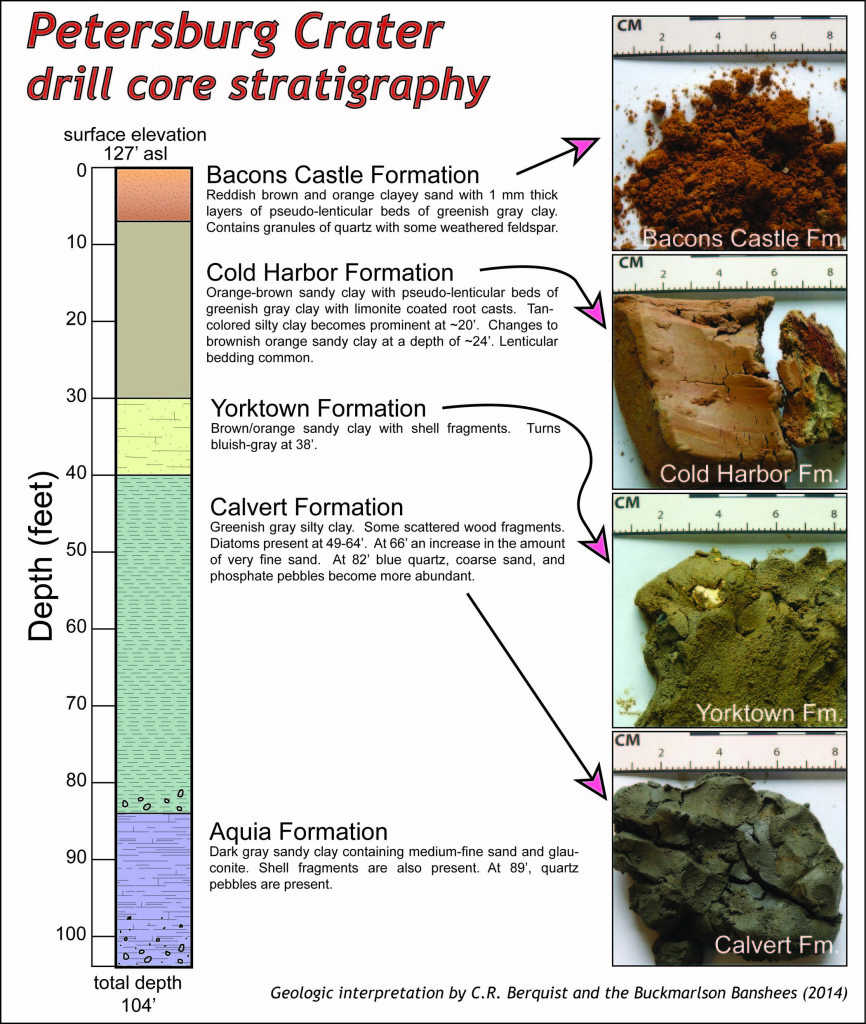
Description and photographs of sedimentary units from drill core at the Crater site, Petersburg National Battlefield. Click for a more detailed view.
The Union tunnel was first cut in the lower layers of the Yorktown Formation and angled upwards gently, as a means to drain subsurface waters out of the tunnel. In the drill core we observed the Yorktown Formation to be clayey fine- to medium-grained sand with shell fragments. It was soft and weak stuff, no doubt a big hassle to excavate, as well as shore up in the tunnel. In many places the upper part of the Yorktown is a soft and sticky clay that formed by weathering of shells, in place, and during the years following shell deposition and burial by the Cold Harbor and Bacons Castle sediments. Although not exactly a marl, the upper Yorktown Formation was clearly the culprit in the Union’s mine difficulties.
The overlying Cold Harbor Formation is named for clays and sands that lie above the Yorktown or Eastover formations in the area of the Cold Harbor battlefields. At Petersburg, this unit is composed of lenticular-bedded sandy clay, with a soft to firm consistency that was both sticky and moist. These sediments are interpreted as tidal flat and marsh deposits; we observed branching limonite-coated root casts in the drill core. Tunneling through the Cold Harbor Formation was both easier and safer than in the weak upper layers of the marine Yorktown Formation.

Geologic cross section of the Union tunnel and Crater site based on our recently obtained drill core data. Click for a more detailed view.
High-energy materials (e.g. gunpowder, TNT, atomic bombs) when detonated at or near the Earth’s surface produce an explosion crater. The rapid release of energy from a point source sends out a shock wave that permanently deforms target materials and ballistically ejects materials outward excavating a bowl-shaped depression or crater in the process. Some ejecta falls back into the crater and also forms a blanket of debris that thins radially outward from the crater. The geometry of the explosion crater is strongly influenced by the mechanical properties of the target or surrounding material. An explosion crater excavated in dry sand, a material with low cohesion, will have smoothly sloped walls with angles of <30˚.
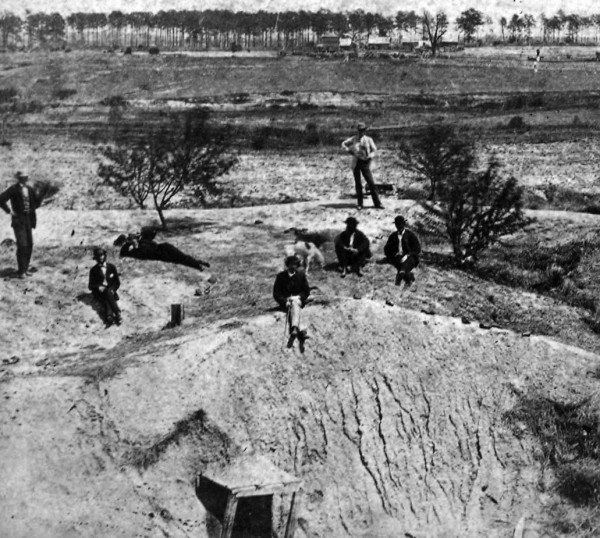
Post Civil War photo of the Crater with tourists for scale. Note the remains of the Union tunnel and steep slopes at the site.
Eyewitness accounts from the Petersburg Crater indicate that the depression itself was irregular in overall shape and had numerous steep walls (likely >45˚). Try walking up a 45˚ slope and you’ll be convinced that 45˚ is a steep slope, and it’d be far worse to traverse that slope while under enemy fire. Additionally, the slopes would have been very slippery. The Union explosive charges were detonated in the Cold Harbor Formation. The cohesive nature of sediments in both the Cold Harbor Formation and at the base of the overlying Bacons Castle Formation contributed significantly to the Crater’s overall shape. Union troops were effectively stuck in the Crater due to its steep morphology, and Confederate troops reassembled on the Crater’s rim subjected the Union soldiers to a grim “turkey shoot”.
Today the Petersburg National Battlefield is a verdant park and the Crater itself a series of modest hummocky depressions framed by mature trees. It’s hard to imagine the ugly scene and hard combat that took place on this spot 150 years earlier. The ultimate failure of the Union attack at the Crater is the result of woeful generalship and poor execution of the original battle plan. Our ongoing research provides the geologic context for the site and it’s clear that the underlying geology played a significant role in the events leading up to and during the Battle of the Crater.
Special thanks to Rick Berquist, Virginia Division of Geology and Mineral Resources and Julia Steele of the National Park Service for help with this piece.
Comments are currently closed. Comments are closed on all posts older than one year, and for those in our archive.

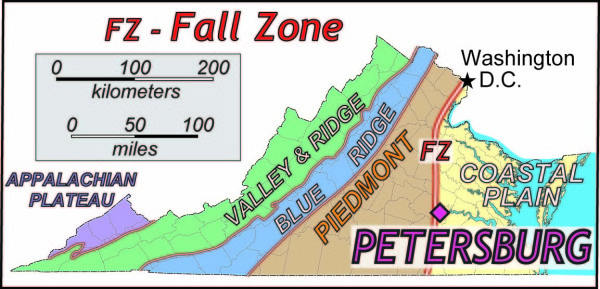
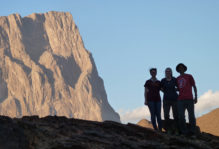
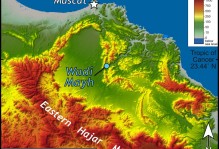
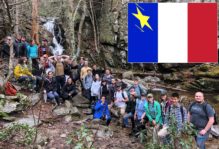
Great article. It’s really great to see the science behind such an interesting battle.
Very interesting. It’s amazing that Civil War sites can provide so many research opportunities to people working in diverse disciplines, from history to geology.
Very interesting article, it’s great to see the some of the science behind all the speculation and hyperbole
Well now thanks to geological survey we can imagine the faces of generalship once they discovered their mistake. Funny thing thoug – as they drilled the tunnel it was not that hard to imagine the effect of explosion and how difficult would it be for their troops to try to climb up the slope.
Fascinating article. Thanks for making it comprehensible to a non-geologist